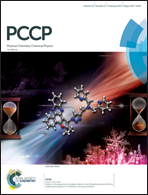Particle-impact analysis of the degree of cluster formation of rutile nanoparticles in aqueous solution†
Abstract
Cluster formation can profoundly influence the bioavailability and (bio)geochemical activity of nanoparticles in natural aquatic systems. While colloidal properties of nanoparticles are commonly investigated using light-scattering techniques, the requirement to dilute samples can affect the fundamental nature and extent of the cluster size. Hence, an alternative in situ approach that can cover a much higher and wider concentration range of particles is desirable. In this study, particle impact chronoamperometry is employed to probe the degree of cluster formation of Alizarin Red S modified rutile nanoparticles of diameter ca. 167 nm in conditions approximating those existing in the environment. Random collisions of individual clusters of the modified rutile particles with a stationary electrode result in transient current signals during a chronoamperometric measurement, indicative of the reduction of the adsorbed Alizarin Red S dye molecules. The results from the particle-impact analysis reveal that the nanoparticles are heavily clustered with an average 91 monomeric particles per cluster. As the spherical equivalent size of the clusters (ca. 754 nm in diameter) is considerably larger than that from nanoparticle tracking analysis (ca. 117 nm), the present work highlights the impact of the dilution on the fundamental nature of the colloidal suspension and introduces the electrochemical determination of the size distribution of inert mineral nanoparticles in highly concentrated media.



 Please wait while we load your content...
Please wait while we load your content...